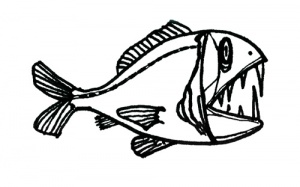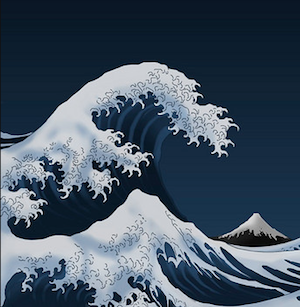Fangtooth
| Fangtooth Class Logo Deep Dive Logo |
|---|
This is the technical specifications of the USS Serenity
Deep Dive
The Deep Dive is a combined project with the Federation Naval Patrol, Starfleet, Pacifica Submersible Research Institute and the Albatross Organisation. The purpose of the project was to design the next generation of Deep Submersible Exploration and Rescue Vessel. They wanted this new vessel to go deeper and faster submerged then any previous design. They also incorporated the latest designed for rescue vessel to increase its operating capacity. It should also be able to travel through space to its destination as well as be able to land on the planet and then when the mission is finished take off again. To help achieve this four retractable impulse engines were added to increase the amount of thrust that was needed to reach orbit. Special warp nacelles that were able to retract into the hull when the vessel was submerged to reduce the amount of drag on the hull as it moved through the water. Specially modified impulse engines were designed and added to the vessel to be able to function in space and under water with out any degradation to power to thrust ratio.
USS Serenity History
The Fangtooth class is the newest class of Deep Submersible Exploration Vessels. The USS Serenity NCC-2891 is the prototype vessel designed under a combined project Deep Dive. She was commanded by Commander Jay and was launched on stardate 2414.03.10
Landing Mode
The Fangtooth class starship was designed for atmospheric flight and planetary landings to be possible on water. The vessels shape allows for atmospheric stability and manoeuvrability while descending and acceding from orbit or the planet surface. It also requires force fields to maintain it’s structural integrity while operating in most gravity wells. The hull shape only allows for a water landing and although it can land on land it will need a heavy duty lifting team to get it back into orbit and to a dry dock for extensive repairs.
Docking Collar
Parts of the Serenity have been changed into triage staging areas that have been connected to airlocks that are specially fitted with a generic docking collars. This enables the Serenity to dock with any known ship type. These docking collars are larger then normal to help facilitate more rapid deployment of the trauma responce teams. These teams under the control of the Trauma Response Team Chief and are comprised of four members who are a doctor, a nurse and two medical technicians. These teams can work independently from each other as well as in one bit group to maximise the transfer of casualties to the Serenity’s sickbay along dedicated corridors. They are also trained in armed and un-armed combat in unfortunate case the need arises.
Sickbay
The sickbay facility on the Serenity has been designed to cope with any medical problem that the crew might have to face. Also due to its rescue component the design of the Serenity has been out fitted with a large compliment of stasis chambers to increase its patient capacity and keep any patient that are to serious to be treated on board. They can be kept in stasis until the Serenity can reach a larger medical facility.
Bridge Design
The design of the bridge of the Serenity has go in a totally new direction. Using the latest ideas and experience in submersible and starship construction it was decided to incorporate all the expertise and change the bridge design. The bridge was covered in a strong, reinforced screen which would show the image of what was happening out side the hull. This gave the bridge crew unprecedented 360 degree view of the out side environment. Small personal screens can be activated for each of the different work stations. It has taken some time for the crew to get use to being able to see the depths of an ocean or deep space below their feet but on whole it has been a receptive design addition.
Technical Specifications
Dimensions
Length: 300 m
Width: 30m
Height: 30 m
Decks: 8
Warp Drive System
Type: Mark XX warp drive
Power: Matter/Antimatter
Retractable Nacelles: 2
Normal Cruising Speed: Warp 9.5 for 24 hours
Emergency Speed: Warp 9.982 for 12 hours
Submerged Speed
Normal Crusing Speed: 160 knots (300 km/h)
Emergancy Speed: 216 knots ( 400 km/h)
Impulse Drive Systems
Type: Type IV Submersible Impulse Propulsion System (IPS)
Power: Deuterium
Main Engines: 2
Retractable Launch Engines: 4
Defensive Systems
Phaser Type: Mark XII arrays
Phaser locations: 6 longitudinally along the length of the hull (2 Dorsal 2 Horizontl 2 Ventral), 2 Aft 2 Forward
Quantum Torpedo Launcher Locations: 4 Forward, 2 Aft
Quantum Complement: 500
Primary Shields: Auto-Modulation Regenerative Shields
Secondary Shields: Auto-Modulation Regenerative Shields
Tertiary Shields: Auto-Modulation Regenerative Shields
Armour: Ablative Hull Armour covering all areas. Ablative hull Armour generator
Tractor Beams: 1 Fore
Torpedo Countermeasures System
Torpedo Intercepts
Torpedo Countermeasures
Transporter Systems and Sensors
Standard (8 Man): 3
Cargo (8 Man Equivalent): 4 (One for each cargo bay)
Long Range Sensors: 30 Light Year Max Range
Takes 1 minute/per light year for intensive scan
Takes 1 second/per light year for standard scan
General scan is almost instant up to maximum range
Auxiliary Craft Carried
Type XI Submersible Shuttlecraft: 4
Escape Pods: 20
Crew Capacity
Normal Complement: 100
Maximum Complement: 150
Maximum Life Support: 250
Medical Maximum Capacity: 400 (In Stasis Chambers)
Misc. Systems
Holodecks: 3

